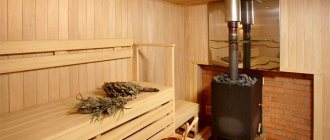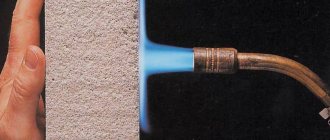With the beginning of the warm spring months, mass construction starts in Russia: owners of dachas, private houses and personal plots begin to renovate their farms. Many people use asbestos-based thermal insulation materials for their new baths or heating systems. This mineral has high performance properties: it does not burn, has low thermal conductivity, does not melt and does not emit harmful fumes. asbestos safe for human health when heated? We will talk about this in this article.
Russian emergency services personnel recommend using asbestos materials to ensure the safety of heating structures in the house.
What is asbestos and what is it eaten with?
Asbestos is the collective name for a number of fibrous minerals used in industry. In addition to their fibrous structure, they are distinguished by their small fiber size (on average from 0.3 to 0.5 microns) and resistance to high temperatures, adverse weather conditions, mechanical stress, etc.
Today, asbestos is mined mainly in Russia and Kazakhstan, which supply almost the entire world with raw materials and finished products. The mineral is mined in open pits, then enriched at plants and delivered to processing plants in hermetically sealed containers. to encounter asbestos fiber in its “natural” form - it is in a bound state in the composition of products, and in production there are powerful air purification mechanisms, which, in combination with personal protective equipment for workers, ensure safety.
Scope of application today
In Russia, despite the undoubted harm to health, asbestos is contained in more than 3,000 different products: it is used for the production of filters and tarpaulins, paper and cardboard, protective suits for firefighters and some asbestos-cement building materials. In our country, it is allowed to be used in many industrial technologies, but its use must be strictly controlled.
By the way, it’s worth making a reservation here. It is not the asbestos products themselves that are harmful to the human body, but the small particles of this mineral suspended in the air. Typically, the suspended state of fine asbestos dust can only be observed during mining, in some technological processes of various industries, or during the destruction of old buildings. To obtain harmful particles in domestic conditions, you will need to purposefully crush an asbestos-containing product (the same slate).
However, any product begins to deteriorate over time. As a result of aging, mineral fibers break down into fine dust, which can become an allergen for the human body. Once in the lungs, harmful asbestos remains there forever. When it grows into tissue, it causes enormous harm to health. Although the first signs of illness may appear only after a few years. It is known that in people who came into contact with such dust, various oncological formations appeared on average only after 7 years; in many patients it took even longer.
Where is asbestos used?
Asbestos is mined by open-pit mining at three deposits: Bazhenovskoye, Kiembaevskoye and Zhitikarinskoye.
Today, more than 300 types of industrial products are made from asbestos . It is widely used in the production of building materials: chrysotile cement slate, pipes, facade slabs, flat facing sheets, filters for chemical production, brake pads, thermal insulation and much more.
Asbestos materials are used in high-tech industries - in the construction of nuclear icebreakers, in the space and military industries, and in the production of railway trains. This fire-resistant material is also used to create special protective equipment for workers who are directly exposed to high temperatures. asbestos in their arsenal , which helps protect themselves when heated in aggressive environments and other harmful influences.
PVC products
Their polyvinyl chloride (PVC) materials are used to make materials for suspended ceilings, wall panels (siding), pipes, and a wide variety of room finishing elements (plinths, moldings, installation fittings for electrical wiring, etc.). The so-called plastic windows, in the manufacture of which PVC is also used, are also widespread. Products produced by European companies that maintain high quality standards are practically safe. The trouble is that the domestic market is overflowing with their low-quality analogues and fakes. Such materials can release dioxin, a powerful carcinogen, and toxic phenol.
Does asbestos affect the human body? Myths and truth
In the modern media space, one can often find statements indicating the harm that asbestos to human health. These theses are often based on myths that have been circulating around one of the most popular materials for more than half a century. Some of them have real grounds, but the general direction of negative rhetoric still has little in common with reality.
Asbestos is credited with many harmful properties - it is accused of causing serious illnesses, polluting the environment, etc. However, the use of this mineral is still not prohibited, despite active pressure from EU countries around the world. In Russia, asbestos is recommended to be used when heating surfaces as a thermal insulation material by official departments, for example, the Ministry of Emergency Situations. Every autumn, rescuers conduct special raids calling on the population to take care of their safety by using the right building materials. This begs the question: is asbestos when heated?
How to avoid harmful effects on humans
In the modern world, the harmful effects of asbestos on humans are impossible, since neither the worker nor the consumer comes into contact with its dangerous variety (amphiboles). Chrysotile asbestos is safe for the health of industry workers and consumers if basic standards are observed. The factories use a system of controlled use of asbestos, which includes installations for filtering indoor air, supplying personnel with personal respiratory protection equipment and special uniforms, as well as special rules for packaging and transporting asbestos fiber. It is worth noting that such a set of safety measures is mandatory for any dusty industries (coal, wood, cement and others).
For the consumer, chrysotile products are safe, since the mineral fiber is in a bound state, losing its natural volatility. De facto, it turns into ordinary dust. Of course, as, for example, when cutting slate, you should protect your respiratory system from fine dust - but the same can be said about working with wood.
Photo: The photo shows an employee of one of the asbestos mining plants in Russia. His clothing is more than enough to ensure safe contact with the mineral.
What happens to asbestos when heated?
In 1938, Russian scientists Ivanov and Popkov drifted on an active lava flow during an eruption in Kamchatka. Asbestos shoes helped them with this.
Asbestos fiber is one of the unique natural materials that has outstanding fire-resistant properties. Some types of “mountain flax” can withstand heating up to 1500°C, which exceeds the combustion temperature of rocket fuel. Moreover, when heated, asbestos do not emit harmful fumes, and if the permissible temperature is exceeded, they become brittle, but do not catch fire.
For humans, heated asbestos is the safest material possible, which, on the contrary, will protect health from flames. Products based on it are included in the mandatory list of items for extinguishing fires. It is not without reason that asbestos fabric is used to make special protective equipment for emergency workers and scientists working in aggressive environments.
How can you get poisoned by asbestos?
Until the 70s of the last century, asbestos was often used in various industries (construction, automotive industry, plumbing, etc.). Roof tiles, corrugated slates, ventilation ducts, etc. were made from asbestos-containing materials. At the end of the 90s, many European countries abandoned the use of this material. This is due to the fact that as a result of medical research, asbestos was included in the first group of carcinogens.
Chrysotile asbestos is included in the group of carcinogens, but it is less dangerous to humans than amphibole asbestos. Therefore, the latter is prohibited from being used. This means that further we will talk only about the chrysotile mineral, which is widely used in production.
Asbestos dust has the highest toxicity, as it penetrates into the human body, causing dangerous diseases.
As a rule, asbestos poisoning occurs in people who work in the industrial sector and come into contact with this material on a daily basis. Roofing and wall products, facade slabs, thermal insulation materials, sealants, bricks, and various building mixtures are made from this material.
In addition, chrysotile asbestos is used in the food, nuclear, automotive, and pharmaceutical industries. Therefore, many people are at risk of intoxication with this substance. True, the degree of poisoning depends on the duration of contact of the respiratory tract with hazardous dust.
A person inhales asbestos dust, which is released during the production of this material or at the time of destruction of products made from it. After this, fragments of its fibers penetrate the respiratory tract and settle on the lungs. Chrysotile dissolves in a slightly acidic environment, so poisoning requires a significant dose of dust or prolonged and regular exposure to it.
As a rule, chronic intoxication takes a long time to develop and provokes structural disorders in the respiratory organs. Therefore, symptoms may take 10 years or more to appear.
Thus, those at risk for asbestos poisoning include industrial workers who regularly inhale toxic dust: miners of this material, railroad workers, auto mechanics, boiler workers, electricians and construction workers. This possibility exists for people who inhale mineral fibers from the ambient air near point sources of pollution.
Where did the myth about the dangers of asbestos come from?
However, nothing is born from nothing. in rumors about the dangers of asbestos , which are greatly distorted both to suit the interests of the product’s competitors, and by public opinion lost in technical details. The fact is that there are two types of mineral - amphibole and chrysotile.
Amphibole asbestos really harms human health. It contains iron, which makes it resistant to acid. Alveolar macrophages, the sanitation cells in the human lung, cannot dissolve these fibers, and they remain for many years. This provokes serious diseases, including oncology. Amphiboles are currently banned worldwide.
Asbestos formulas:
- Amphibole group:
- Crocidolite - (Na2Fe32+Fe23+)Si8O22(OH)2
- Tremolite – Ca2Mg5Si8O22(OH)2
- Amosite - (Fe2+, Mg)7Si8O22(OH)2
- Anthophyllite - (Mg, Fe2+)7Si8O22(OH)2
- Actinolite – Ca2(Mg, Fe2+)5Si8O22(OH)2
- Chrysotile – 3MgO•2SiO2•2H2O
Chrysotile asbestos is a hydrous magnesium silicate. It is not acid resistant, allowing macrophages to dissolve it and remove it from the body in a short period. Chrysotile is recognized as safe under controlled use and is used in industrial products. This is where the myth about the dangers of asbestos for human health takes its roots - people mix two similar in name, but, in fact, completely different types of “mountain flax”.
Analogues and substitutes of material
There are no full-fledged functional analogues for chrysotile asbestos products. The combination of absolute non-flammability, low thermal conductivity, resistance to mechanical damage, combined with low cost, gives a unique set of properties. However, there are synthetic analogues of chrysotile products that can be compared with fiber in certain parameters. They are usually more expensive to produce and are also not safe for human health. Thus, when working with glass wool, an analogue of asbestos in the field of thermal insulation, it is necessary to use personal respiratory protection and a special uniform that will protect the worker’s skin.
To summarize, we can say this. In modern times, asbestos does not cause harm to health when heated, as with other types of use. The opinion about the negative impact of “mountain flax” is an echo of the information storm from the last century, which does not reflect the real state of affairs. Asbestos, which is harmful to health, was banned decades ago. In addition, it was not used for civilian purposes in Russia and Eastern European countries.
Asbestosis
Asbestosis is a pulmonary disease that develops when asbestos dust enters the respiratory system. Having accumulated in sufficient quantities, asbestos particles contribute to the formation of scars on mucous tissues. The lesions affect large areas. The scars that appear impair the functioning of the bronchopulmonary system, triggering the following pathological processes:
- lung tissue loses elasticity;
- the function of the lungs is impaired, they cannot compress and unclench normally;
- shortness of breath appears;
- the gas exchange process (carbon dioxide and oxygen) is disrupted.
Learn about the symptoms of styrene poisoning at home and at work, first aid for intoxication, treatment.
Read about glue poisoning: symptoms, first aid and treatment.
All processes lead to a dry persistent cough, which is accompanied by pain in the sternum area. The person develops shortness of breath and a feeling of tightness in the chest. The disease is very dangerous; it can develop into carcinoma.
What is the danger of asbestos cement?
Some consider the health hazards of slate to be a real fact, while others attribute it to an imaginary threat inflated by manufacturers of more expensive roofing materials. There are ongoing discussions on this issue, in which each side presents its own arguments. Oddly enough, to some extent both are right.
For the sake of fairness, it is worth noting that the components involved in mixing the initial solution include a component that is considered harmful - asbestos fiber. It is considered as a source of carcinogenic substances, which, when entering the human body, can cause serious diseases, often leading to death.
- chrysotile asbestos – resistant to alkali, but soluble in acids;
- amphibole asbestos - weakly reacts to acids, but decomposes in an alkaline environment.
From the above we can conclude that the second group of asbestos is the most harmful for living organisms, but it was this group that was used in the production of European slate due to the absence of chrysotile asbestos. In post-Soviet countries the situation is different. Here, in the manufacture of roofing sheets, chrysotile asbestos is used, which is less dangerous to human health.
The notoriety of asbestos has also affected domestic production, although chrysotile asbestos poses several times less danger compared to amphibole asbestos used in foreign enterprises.
Material properties
Similar natural silicate materials are combined under one name. Huge deposits of raw materials are concentrated in the Ural deposits. In these places it is called stone tow. They are also called mountain flax and mineral wool. Indeed, these names suit the frayed asbestos fibers.
The harm from another asbestos – amphibole – is more noticeable. It has a different fiber structure and chemical properties. This material, which causes serious diseases - asbestosis, bronchitis, cancer, is an active carcinogen, and is prohibited for use in all countries, including Russia. Previously, it was mined in the USA and Australia.
Harm to health
Many studies have been conducted until it has been scientifically established why this material is harmful to humans. The danger comes from inhaled asbestos dust, which is formed when objects made from it are destroyed. Prolonged inhalation of such dust can cause bronchitis and asbestosis (silicatosis) - the formation of scars on the tissues of the respiratory system due to the accumulation of settling asbestos particles. There is evidence that with prolonged exposure to the body, asbestos causes cancer.
There is a theory that asbestos-cement sheets are not harmful during normal use, but arise only when heated. Due to the fact that the material does not burn, it is often used for the production of products exposed to high temperatures. The question arises as to whether asbestos sheets are harmful when heated. When heated, the material emits vapors of harmful substances, so it is better not to use it in the construction of baths. The consequences of asbestos poisoning can take years to become apparent. For asbestos-cement (aceite) sheets, the harmfulness is reduced by carrying out a number of measures, for example, painting the products.
Due to the fact that sheet asbestos, a material often used in construction, is harmful to health, many today are thinking about replacing it with more environmentally friendly analogues. The question of what can replace asbestos sheets is not an easy one, since this raw material has also gained popularity due to its cost-effectiveness.
Exact analogues of this material have not yet been found, but there are substitutes:
- In electrical engineering, asbestos cement is replaced by various plastics, for example, fiberglass.
- Asbestos-cement products are replacing materials made from basalt, carbon, and aramid fibers.
- Due to information about the dangers of asbestos when heated, asbestos fabrics, which for many years served as the main material of protective clothing, are being successfully replaced with heat-resistant polymer ones.
- Asbestos sealing cords for moving parts have given way to textile structures made of fluorine fibers.
- Glass and carbon plastics have replaced asbestos plastics in the production of electrical insulating parts.
Today, the chrysolite mineral is recognized as relatively safe. The main factor for its harmless use is complete control of use:
- High density of the products used, preventing excessive crumbling of the material.
- Dispose of dust in sealed containers.
- Measuring the level of asbestos fibers in production.
- Multiple coating of partitions and panels.
- Regular wet cleaning and disinfection of premises.
- Systematic medical examination of workers.
Subject to sanitary standards and necessary precautions, the harm of asbestos to humans can be minimized. https://www.youtube.com/embed/YxSLn_SnIbc
How dangerous is asbestos?
After research, it turned out that asbestos is a carcinogenic substance, and with direct contact it can cause irreparable harm to the body. Inhalation of particles resulted in increased morbidity and even mortality among employees of enterprises and mines.
Note! To work with asbestos material, special protective equipment is required, and critical indicators of the concentration of asbestos dust have been determined.
Asbestos cord in production
Asbestos particles initiate the occurrence of incurable diseases such as asbestosis, mesothelioma and lung cancer. Therefore, all production facilities for the production of asbestos products were immediately curtailed and a campaign to remove asbestos products from residential premises began.
In old houses you can always find the presence of asbestos materials. First of all, it is necessary to remove the existing roof covering containing asbestos compounds. Sewer pipes, lining of garages and other utility rooms can be made from similar material.
Your home should be cleared of harmful material immediately. To do this, it is necessary to thoroughly check the entire structure for the absence of asbestos products and contact a construction company for their dismantling and removal. Such organizations have the necessary equipment and experience in handling asbestos. Specialists will replace asbestos structures with high-quality Venti Butts materials and dispose of removed products.
When performing work yourself, you should use personal protective equipment and follow certain rules for handling asbestos materials.
- First of all, you should not saw, break or crush the material in any way; asbestos dust does not lose its toxic properties even over a long period of time.
- In case of emergency, the material being cut should be moistened and dust collected on a sheet of polyethylene for further disposal.
- Loading and transportation of asbestos waste is carried out in a special closed container.
- The material is buried at separate landfills or in specially designated places; failure to comply with this requirement may lead to the imposition of penalties by regulatory authorities.
Opponents' arguments
A number of scientists argue that the danger of asbestos-cement slate is too exaggerated. In fact, they believe, there is no need to abandon the roofing material that has been proven for decades. It is simply necessary to protect workshop workers by providing them with personal protective equipment. The same applies to roofers who have to cut slate sheets, and home craftsmen who independently install a roof or erect a fence from asbestos concrete sheets.
An indirect argument in favor of a “harmful” roofing material can be considered the fact that modern types of asbestos-free slate also include reinforcing fibers:
- polyethylene;
- cellulose;
- polypropylene;
- carbon, etc.
Their potential safety for humans has not yet been fully studied. Perhaps too little time has passed to announce final results and conclusions. Although it is likely that there is also a commercial component in this issue, which affects the increase in the rating of new roofing materials. But be that as it may, some experts are sure that it is still too early to talk about 100% environmental purity of modern slate.
Often, those who prove the danger of asbestos cement for the health of others make a statement about the weathering of harmful particles from the surface of roofing sheets. But opponents believe that this is not true, since chrysotile and cement are in strong adhesion. And if no one deliberately scratches the asbestos-cement fibers out of the slate, then they will not be able to fall out on their own.
In general, opponents' arguments are based on the assertion that only asbestos dust that appears during the cutting or mechanical destruction of slate sheets is harmful. But if they are simply lying in the yard or on the roof, then there can be no talk of any danger. According to the assurances of defenders of such a popular roofing material, the fuss about slate was raised only in order to promote non-asbestos analogues on the market.
01/23/2017 at 16:01
ASBESTOS, asbestos ores (from the Greek asbestos - inextinguishable, indestructible * a. asbestos, asbestus, earth flax, mountain flax; n. Asbest; f. asbeste, aminate; i. asbesto), - a group of fibrous minerals that have the ability to split into the finest flexible fibers. According to their chemical composition, asbestos minerals belong to the class of hydrous silicates of magnesium, iron, partly calcium and sodium. Based on mineralogy, characteristics and crystal structure, they are divided into chrysotile-asbestos and amphibole-asbestos.
Consequences of poisoning, prognosis
Only chrysolite asbestos is used in production. Therefore, intoxication is recorded in people only with this type of mineral.
Typically, asbestos poisoning occurs in workers who come into contact with carcinogenic material on a regular basis. For example, chrysotile is used in metallurgy, mechanical engineering, pharmaceuticals, food and nuclear industries. Therefore, many people are exposed to intoxication every day.
Attention!
Intoxication is not immediately noticeable; asbestos dust accumulates in the body gradually. The first signs of poisoning may appear after 10 years.
The human lungs are affected by asbestos dust, which occurs as a result of mining, destruction of this mineral, or when heated. Chrysotile has the ability to dissolve in an acidic environment. For poisoning to occur, prolonged and regular exposure to asbestos dust is required.
The severity of clinical manifestations depends on the duration of exposure to mountain flax on the body. The mild form develops with exposure for 4-5 years, the moderate form - 8-10 years, the severe form - more than 10 years. The longer a person is in contact with harmful material, the clearer the signs of poisoning.
Typically, intoxication is accompanied by the following conditions:
- general weakness;
- constant overwork;
- pale skin;
- sudden loss of body weight.
In case of chronic poisoning, a person complains of a debilitating cough, chest pain, and shortness of breath. Deformation of the phalanges of the fingers and warty growths are clear signs indicating intoxication. When diagnosed, the patient is diagnosed with pleurisy, emphysema or bronchitis.
Some of the most dangerous complications that arise from asbestos exposure include:
- cancer of the lungs, larynx, heart, ovaries;
- bronchial asthma;
- pulmonary fibrosis;
- pneumonia.
Very often, intoxication is accompanied by rheumatoid arthritis, tuberculosis, and persistent digestive disorders. The prognosis depends on the duration of exposure to asbestos dust and the severity of structural changes. Thus, with pulmonary fibrosis the prognosis is unsatisfactory. The outcome is extremely unfavorable for lung cancer. In most cases, the patient dies.
Asbestos is extremely harmful to health. Its harmful properties appear gradually; signs of poisoning may appear after several years. To avoid the development of serious diseases, it is necessary to follow safety rules when working with carcinogenic material. People who have been in contact with asbestos and its derivatives for a long time should regularly monitor their condition with a doctor at least twice a year.
Asbestos in nature
Chrysotile asbestos deposits are genetically associated mainly with ultramafic rocks and are formed during the process of their serpentinization under the influence of hydrothermal solutions associated with granitoid intrusions. In general, asbestos deposits have a zonal structure, in which a gradual change in the nature of asbestos content and a decrease in the thickness of the veins and the length of asbestos fibers are observed from the center to the periphery.
The largest deposits of chrysotile asbestos in the CCCP are Bazhenovskoye, Krasnouralskoye (Middle Urals), Dzhetygarinskoye and Kiembaevskoye (Southern Urals), Aktovrakskoye, Sayanskoye, Ilchirskoye (Sayans), Molodezhnoe in the north of Transbaikalia (Buryat ACCP). Abroad, large deposits are known in Canada (the province of Quebec, British Columbia, Newfoundland), Zimbabwe (Zvishavane and Mashava), the USA, Italy, Yugoslavia, France, Japan, Brazil, Australia, China, and the island of Cyprus.
Contact-metasomatic deposits of chrysotile asbestos in sedimentary magnesium-carbonate rocks are small in size, but may be of industrial interest as a source of iron-free asbestos. In the CCCP, deposits of this type are known in the Krasnoyarsk Territory (Aspagashskoe, Bis-Tag), Uzbekistan (Sary-Cheku) and Kyrgyzstan.











